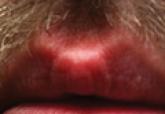Case Letter

Vibratory Angioedema in a Trumpet Professor
We present a case of a 38-year-old man, a trumpet professor, who reported pain, swelling, and redness of the upper lip within 20 minutes of...
Mehmet Ali Nahit Şendur, MD; Sercan Aksoy, MD; Nuriye Yıldırım Özdemir, MD; Şebnem Yaman, MD; Nurullah Zengin, MD
Drs. Şendur and Özdemir are from the Department of Medical Oncology, Yıldırım Beyazıt University, Faculty of Medicine, Ankara, Turkey. Dr. Aksoy is from the Department of Medical Oncology, Hacettepe University, Cancer Institute, Ankara. Drs. Yaman and Zengin are from the Department of Medical Oncology, Ankara Numune Education and Research Hospital.
The authors report no conflict of interest.
Correspondence: Mehmet Ali Nahit Şendur, MD, Yıldırım Beyazıt University, Faculty of Medicine, Department of Medical Oncology, 06800 Bilkent, Ankara, Turkey (masendur@yahoo.com.tr).

Isolated angioedema following nonsteroidal anti-inflammatory drug (NSAID) ingestion typically involves the face, particularly the periorbital skin, lips, and mouth. These patients may develop urticaria and/or angioedema only after NSAID ingestion, but they do not have underlying chronic urticaria. The authors report a rare case of isolated unilateral eyelid angioedema with flurbiprofen.
To the Editor:
Flurbiprofen, a member of the phenylalkanoic acid derivative group of nonsteroidal anti-inflammatory drugs (NSAIDs), are commonly used to treat fever, inflammation, and pain of arthritis.1 The exact prevalence of allergic reactions to NSAIDs in the general population is not known. Rhinoconjunctivitis, bronchospasm, urticaria, angioedema, and anaphylaxis can occur as an allergic reaction to NSAIDs. Isolated angioedema following NSAID ingestion typically involves the face, particularly the periorbital skin, lips, and mouth.2 These patients may develop urticaria and/or angioedema only after NSAID ingestion, but they do not have underlying chronic urticaria. We report a rare case of isolated unilateral eyelid angioedema with flurbiprofen.
A 39-year-old man presented with the onset of unilateral angioedema of the left upper eyelid that had developed approximately 30 minutes after taking flurbiprofen (100 mg). He reported frequent use of flurbiprofen for headaches. The patient also had a history of taking aspirin, ibuprofen, diclofenac, etodolac, and naproxen sodium as needed for migraines with no prior angioedema. He had no history of chronic urticaria or allergic disease. The patient was treated with oral pheniramine hydrogen maleate and angioedema resolved after 12 hours. Three days later, the patient used flurbiprofen again for a headache. He was readmitted to our clinic with unilateral angioedema of the left upper eyelid (Figure). The symptoms started approximately 30 minutes after taking flurbiprofen. Angioedema resolved within 1 day with oral pheniramine.
Nonsteroidal anti-inflammatory drugs are the most commonly prescribed class of drugs in the world and are the most common cause of all adverse drug reactions.3 Urticaria, angioedema, and anaphylaxis are common adverse reactions to NSAIDs. The prevalence of urticaria and angioedema to NSAIDs has been reported to be 0.1% to 3% worldwide.4
Angioedema is an abrupt localized swelling of the skin and mucous membranes of the face, lips, mouth, throat, larynx, extremities, and genitalia. Angioedema generally develops over minutes to hours and resolves in 24 to 48 hours.5 Angioedema without urticaria is the clinical syndrome that can be caused by an adverse drug reaction. In an Italian review of 2137 reactions, NSAIDs were causative agents in 33.6% of patients with drug-induced angioedema.6 In another study, Leeyaphan et al5 reported that 50% of patients with drug-induced angioedema resulted from NSAIDs, commonly with ibuprofen and diclofenac. Although angioedema is due to inhibition of cyclooxygenase 1, overproduction of leukotrienes, and possibly IgE-mediated reactions to single drugs,7 localized unilateral eyelid angioedema with NSAIDs is rare. The exact mechanism of localized eyelid edema is not known.8 We believe that the unilateral eyelid angioedema in our patient was caused by flurbiprofen use because the reaction recurred when the drug was used again.

We present a case of a 38-year-old man, a trumpet professor, who reported pain, swelling, and redness of the upper lip within 20 minutes of...
Angiotensin-converting enzyme (ACE) inhibitors frequently are prescribed for the management of cardiovascular disorders. In addition to their...
Angioedema is a variant of urticaria that causes deep dermal and subcutaneous swelling. It frequently is a unilateral reaction and usually lasts...
